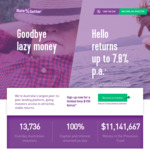Saw an ad in Money Magazine(read for free on PressDisplay) for new signups to RateSetter.
They are offering a $150 bonus when you invest $2000 in either a 3 or 5 year loan. This is the biggest bonus including referrals for Ratesetter. $150 bonus will be paid within 30 days. T&C
So putting aside the interest rate (currently ~6.1% p.a. for 3 years) a $150 return on $2000 equates to 7.50% total or 2.44% p.a.
Keep in mind that this is not eligible for capital gains tax (e.g. 50% discount on tax) as this will just count towards your annual income. Things like ETFs may be an alternative option. Tax-wise, investing in your Super may be a better alternative due to lower 15% tax albeit it's locked away until you retire. You should always consider taxation with your investments. At the end of the day, the government always wins! Seek professional advice as this is just a general comment.
Read the comments from the past 4 years of deals. The negative comments in previous Ratesetter deals have been accusations of being Ponzi scheme. None of this has ever eventuated however past performance doesn't indicate future results. Also a worry for some negative commenters has been what happens if the defaults get too high. I've included the tables below:
Current Funds on Loan (as of time of posting):
| Status | Value | % of total funds on loan |
|---|---|---|
| Loan up to date | $189,769,695 | 94.74% |
| Payment up to 30 days late | $192,884 | N/A |
| Loan 1 month in arrears | $1,293,863 | 0.65% |
| Loan at least 2 months in arrears | $3,603,369 | 1.80% |
Statistics since Inception
| Total amount lent | $409,703,473 |
| Total principal repaid by borrowers | $209,394,265 |
| Current funds on loan | $200,309,208 |
| Current estimated bad debt rate* | <3.9% |
| Current estimated bad debt* | $7,717,382 |
| Current estimated default coverage ratio* | 1.4x |
Australian financial services licence number 449176
Australian credit licence number 449176
ABN 571 666 466 35

